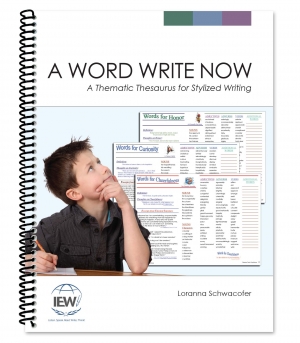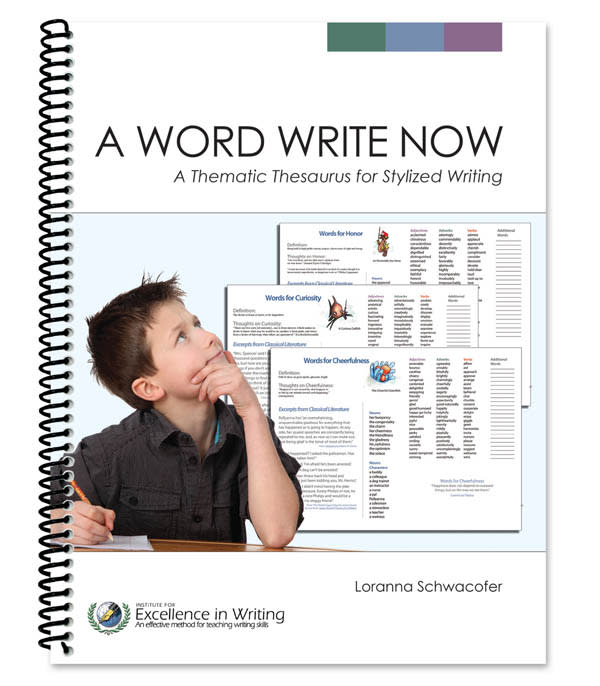A Word Write Now: A Thematic Thesaurus for Stylized Writing is a reference tool for writers of all ages that functions as a simplified thesaurus. Being able to come up with just the right word to enliven your writing is daunting, especially for young writers with a more limited vocabulary. Many composition courses encourage students to use a dictionary or a thesaurus to come up with more interesting vocabulary, but before they can look something up, they have to have a related word in mind to use as a starting place.
A Word Write Now makes the process much easier since it allows students to drill down from general to more specific word categories.
The book has three main sections that are titled Character Traits, Descriptive Words, and Words for Movement and the Senses. These sections are then refined into smaller categories. For example, a student who wants to describe an evil character can search the subcategories under Character Traits, perhaps focusing on subcategories such as Dishonesty and Lawlessness. For each subcategory, there is a definition of the category heading word, literary quotes related to the topic, and lists of words further categorized by parts of speech. Students can find nouns that portray a dishonest character such as a blackmailer, a charlatan, or a knave. There are nouns that convey their actions such as deceit, fraud, and hoax. Students can choose from adjectives such as corrupt, double-crossing, scheming, and underhanded. Their actions might be described with adverbs such as craftily, fraudulently, and treacherously. And the dishonesty of the character’s actions might be conveyed with verbs such as dupe, hoodwink, scam, and snooker.
The second main section, Descriptive Words, presents words under the subcategories of Appearance, Color, Size, Time, Temperature, Texture, and Shape. Those sound like very limited categories. However, these categories are more expansive than their titles sound. For instance, under the time category, students will find the expected groups of words about the time of day, measurements of time, seasons, and so on. However, there are also unexpected groups of words such as Nouns for Aging (e.g., juvenile, elder, and senior); adjectives under the categories Older Things, Newer Things, and Maturity; and a category with Phrases to Express the Need to Hurry (or Not) such as “Don’t dilly-dally!” and “Shake a leg!”
The third section, Words for Movement and the Senses, has the subcategories of Feet, Hands, Hearing, Seeing, Smelling, Speaking, and Thinking. Like the first section of the book, the subcategories include lists of nouns, adjectives, adverbs, verbs, and phrases along with related quotes from classical literature.
The appendix has useful extras. For example, “Playing with Words” has tips for game-like activities. I know from my own experience that most students enjoy playing out loud with word possibilities, testing words to find those most suitable. The results can be silly, but they often provide opportunities for on-the-spot vocabulary lessons as you discuss or explain the meanings and nuances of particular words. The appendix also has lists of transition words and prepositions that students can use to construct more complex sentences and create better flow in their compositions.
It is worth mentioning that there are blank lines on the sub-category pages for students to add their own words that they discover.
It is no surprise that A Word Write Now is published by the Institute for Excellence in Writing, the same company that publishes Teaching Writing: Structure and Style, an approach to teaching writing that requires students to dress up their writing with lively verbs, colorful adjectives, and interesting adverbs. But even if you use a resource other than TWSS for teaching composition skills, A Word Write Now should be very helpful.









